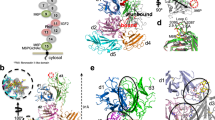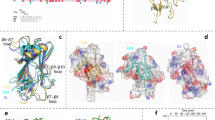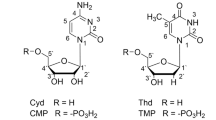Abstract
PHOSPHOMANNOISOMERASE was found in red cells of the pig. The enzyme catalyses the reaction mannose-6-phosphate ⇌ fructose-6-phosphate Enzyme activity was determined by measuring the rate of formation of fructose-6-phosphate. The method was as follows: 1 vol. packed cells + 4 vol. ice-cold distilled water were frozen and thawed several times. 1.0 ml. of this hæmolysate, corresponding to 0.2 ml. original packed cells, 1.0 ml. acetate buffer, 0.1 M, pH 5.6, and 1.0 ml. mannose-6-phosphate (sodium salt 0.03 M, pH 5.9) were kept at 37° C. for the appropriate time and deproteinized by the addition of 3.0 ml. ice-cold 10 per cent perchloric acid. The deproteinizing agent was added to the blank before mannose-6-phosphate. The method of Roe1 was chosen for the determination of fructose-6-phosphate in the filtrates. Because of the big excess of phosphoglucoisomerase in red cells2 the fructose-6-phosphate measured is in equilibrium with glucose-6-phosphate at any stage of the reaction (60 and 40 per cent of glucose-6-phosphate and fructose-6-phosphate respectively at 37° C.) This was confirmed by determinations of glucose-6-phosphate with triphosphopyridine nucleotide and Zwischenferment3 and colorimetric measurements of fructose-6-phosphate in corresponding filtrates. The total original amount of fructose-6-phosphate was calculated by multiplication of that found by 2.5.
This is a preview of subscription content, access via your institution
Access options
Subscribe to this journal
Receive 51 print issues and online access
$199.00 per year
only $3.90 per issue
Buy this article
- Purchase on Springer Link
- Instant access to full article PDF
Prices may be subject to local taxes which are calculated during checkout
Similar content being viewed by others
References
Roe, J. H., J. Biol. Chem., 107, 15 (1934).
Bruns, F. H., and Vahlhaus, E., Naturwiss., 43, 180 (1956).
Kornberg, A., J. Biol. Chem., 182, 805 (1950).
Lehninger, A. L., Physiol. Rev., 30, 393 (1950).
Malmström, B. G., Dissertation, Upsala, Sweden (1956).
Vallee, B. L., “Adv. Prot. Chem.”, 10, 317 (1955).
Bruns, F. H., and Okada, S., Nature, 177, 87 (1956).
Topper, Y. J., and Stetten, jun., DeW., J. Biol. Chem., 189, 191 (1951). Topper, Y. J., ibid., 225, 419 (1957).
Slein, M. W., J. Biol. Chem., 186, 753 (1950). In Colowick, S. P., and Kaplan, N. O., “Methods in Enzymology”, 1, 299 (Acad. Press, Inc., New York, 1955).
Author information
Authors and Affiliations
Rights and permissions
About this article
Cite this article
BRUNS, F., NOLTMANN, E. Phosphomannoisomerase, an SH-Dependent Metal-Enzyme Complex. Nature 181, 1467–1468 (1958). https://doi.org/10.1038/1811467a0
Issue Date:
DOI: https://doi.org/10.1038/1811467a0
This article is cited by
-
Polymorphism and linkage for mannosephosphate isomerase in Mus musculus
Biochemical Genetics (1973)
Comments
By submitting a comment you agree to abide by our Terms and Community Guidelines. If you find something abusive or that does not comply with our terms or guidelines please flag it as inappropriate.



